Today, I raise a toast to the flavors of Himachal Pradesh.A toast to celebrate the Himachali dham.A toast to accolade the presence of Rajma Madra, Teliya Maah, Sepoo badi, Khatta, and the Dhotwa Daal.A toast to the innumerable years of the unadulterated Chambyali dham, Kangari dham, Mandyali dham, and Bilaspuri dham.A wish of long life to the finger licking Himachali dham.
As I write, thinking about the mouth-watering Himachali dishes, I must confess that my mouth is already watery.
History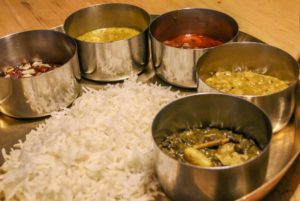
Dham is the age-old celebration which has managed to retain its credibility. It is aligned with the science which enhances the health. Any occasion in Himachal Pradesh is marked by the finger licking food which is shared with the family and friends. The food served in functions, occasions and celebrations is called the dham.
As the legend has it that the concept of dham in Himachal originated in Chamba district. The king of Chamba was believed to be a great food enthusiast. He had a specific weakness for Kashmiri food.
To satisfy his taste buds, he ordered his chef to prepare a dish close to Kashmiri taste. The chef prepared the dish in ghee and curd without onion and tomatoes.Chamba had ample Rajma, therefore it was chosen as the main ingredient of the dish.The obedient and efficient chef with all the local ingredients prepared Rajma Madra.
Rest is history. He was rewarded by the king for this preparation. Rajma Madra is the garnishing of the Chambyali dham. It is famous worldwide.
It is also believed that Dham is the stawick food which was prepared as Prasad in the temples which was then distributed among people.Satwick food is the non-stimulating food which calms down the mind and provides energy.
Chambyali dham
Chamba is believed to be the place of origin of the dham. Auriyali dal is its first dish to be served followed by Rajmah Madra.Next in the queue is the sweet dish which is succeeded by Teliya Maah and the Chamba kadhi.The main dish Rajmah Madra is served by the main boti. Chambyali dham has another outstanding dish known as kadhi served in it which is made with the local mushroom. This variety of mushroom is known as guchi in the local dialect.
It is said that in olden times people started eating only after the main boti came and said ‘Jai Maharaj” in a loud voice to the people sitting in the paint to which all of them replied echoing the same words again. The legend has it that the madra is the gift of Chamba which was taken to Kangra by the Chambyali girls married in Kangra.
Kangari dham
The gravies of Kangari dham are prepared in curd. It is because they assist in quick digestion of rich and heavy food. The food is rich as it is made in ghee, khoya, and curd. The Kangari dham starts with chick pea madra or the moong dal. This is followed by mash dal. This specific dal is made by mixing three types of dals which are moong, urad, and masoor. Maash dal is made by the dhuuni technique.After it, khatta is served. This dish not only digests the heavy madra fats in the stomach but also cleans the ghee on the fingers tips. The kangari dham ends with meete bhath( sweet rice). In this district the dham is served in a Vedic manner to aid digestion. Its special color and flavor is brought by using the powder of burnt and crushed whole walnuts.
Mandyali dham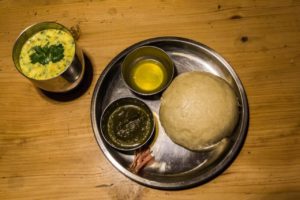
This dham is served while keeping in mind the ultimate rule for mindful and healthy eating pressed for by sage Sushruta. In his Sushruta Samhita, he advocates starting the food with a sweet-dish. It should be followed by salty food item and capping it with a khatta. Therefore, the mandyali dham starts with a sweet-dish which is mostly the boondi meeta . This is followed by its world-famous sepoo badi. Sepoo badi is a local preparation of the district.Then Khatta of pumpkin as well as kolth(small red lentils) are offered. After which black lentils prepared in ghee are served. To end it Jhol is given in a glass. This is made by adding water to the curd in a clay pot.
Bilaspuri dham
This dham has Dhotuwa dal as it specialty .This specific dal and the kadhi pakora are the main dishes which people look forward to in this dham.In Bilaspuri dham, the sweet dish is served in the end.
The preparation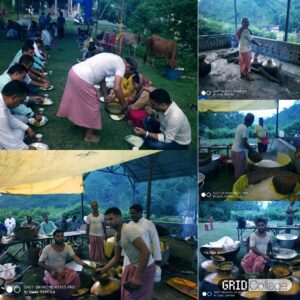
To get the finger licking taste of Himachali dham, the preparations starts a day before it is to be served.In the previous days, a dham was a celebration of the agrarian society. Every household contributed its share of milk, buttermilk or the seasonal vegetables like the pumpkin in the dham. It was not just the edible items they helped in, they also assisted the boties in the cutting and chopping. Therefore, dham became an event to celebrate the togetherness.
On the day of the dham, the boties dig a trench in the ground. It is then filled by the firewood which has been previously dried up. This firewood is called Samdha in the traditional technical language. The food is cooked in the huge round copper vessels which are called the charoties or the baltoies. The iron vessel is used to cook khatta in specific.
Boti and the Painth
The people designated to prepare the dham are called the Boties. Their generations have been in this trade.They have special recipes which have been passed to them by their ancestors.
They take bath and wear new cotton dhoti and a cotton undershirt before they enter the kitchen made for the dham.This is their dress for the day. They do not wear footwear while cooking as well as serving. An important person in their team is known as panihara. He is assigned the duty of serving water and cleaning the place where the food is served.
People eat sitting in the painths that are the lines. They start eating only after everyone has been served and sand up only after everyone has finished.To say a no to the dish, a palm should be spread over the pattal and the boti will understand that you do not need it.He will serve the dish to the nest person. This is the rule of eating dham while sitting in the painth.
They are served food by the boties on the leaf of tur or sal tree leaves(Pattal). These are the biodegradable plates which also cleans the ghee from the figure tips. All you need to do is to wrap your patal after eating and wipe your fingers on the back of it.
The people also eat barefoot, taking care of the hygiene the panihara helps them washing their hands and the pattal before they eat.
Science and Nutrition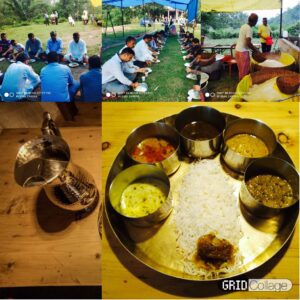
Himachali Dham is filled with nutrition and is considered to be a complete food by the Ayurveda. The four main dams of Himachal which are the Chambyali dham, Kangari dham, Mandyali dham, and the Bilaspuri dham are made without onion, tomatoes, and even garlic. The gravies are prepared by mixing curd, khoya and the spices which vary from district to district. kangari dham is made with the dhuuni technique. In it, a few pieces of burning coal are kept in a bowl which is placed in between the vessel which is filled with food. Then mustard oil is poured on it before covering the vessel containing food with a lid. It gives a rare tempting aroma to the dish.
A scientific of serving the Himachali dham
The Himachali dham is served in different ways in every district. It is served in measured quantities by the expert bodies. In Chamba, auriyali moong dal is the first to be served which is then followed by the sweet dish. It ends with a khatta.
While in Mandi it starts with serving sweets in the beginning and ends with kadhi.Kadhi is consumed as the astringent food for the better digestion and for the healthy mind and a sound body.
These days people like to sit on the table and chair while having the dham with a spoon. This has taken the wastage of food in the functions to a new high and has diluted the benefits of the dham.However, it still holds strong to its grounds. The state government has much tourism hotels offering dham. The private restaurants are well known as well.
Where to eat it?
One of the famous places is a restaurant in Marinda. Another one is on the Palampur chowk. The state capital Shimla has a fine dining restaurant ”Himachali Rasoi”. These places have a heavy footfall of national as well as foreign food enthusiasts of every age enjoying the flavors of Himachal here.
The benefit of sitting on the floor and eating.
The people sit on the ground with their legs crossed. This is a scientifically proven the best way to eat food.while a person sits down and eat, it helps to digest the food better. Sitting in sukhaasan makes your body stronger and flexible. It also helps in improving the digestion which further results in weight control. It not only relaxes the mind and calms your nerves but also improves the blood circulation and makes the heart stronger.This is a shortcut to keep your knees and hip joints healthy and also improves your body posture.
Perks of eating with our hand.
When we eat with our hand, it promotes health. This is due to the good bacteria named flora present in our fingers. It aids in better digestion. Moreover, when the figure tips come in contact with the food, the mind prepares to digest the spices and the texture of the food the fingertips are mixing.
It is a proven way to control overeating and to stay fit. As it is said that when we eat with the hand, we eat mindfully. According to the Vedas, our figure tips are related to the seven chakras of our body. Therefore, the massage of the fingertips while eating with the hands help us in every possible way.
Its also believed that eating with hands also aids in preventing type two diabetes. This has a simple correlation. As when we eat with the hand we eat slow.eating fast is related to the sugar imbalances in the body. As you eat slow and mindfully, the digestion is better, as a result, the sugar level gets balanced in the byody.



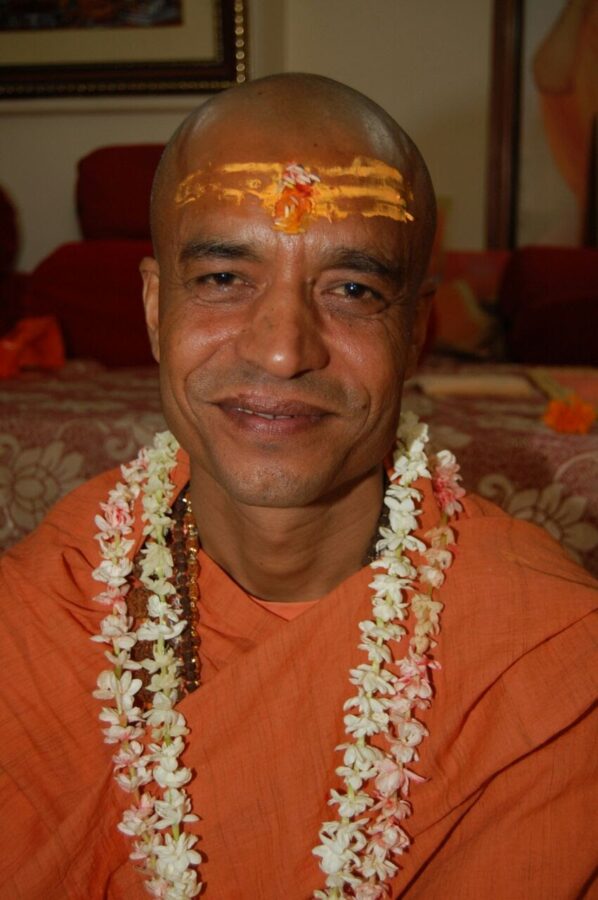

What a mouth watering and scientific description of Dham, I loved reading every bit of it, Never knew dham has originis in chamba , Very well researched article
Keep it up Shalini